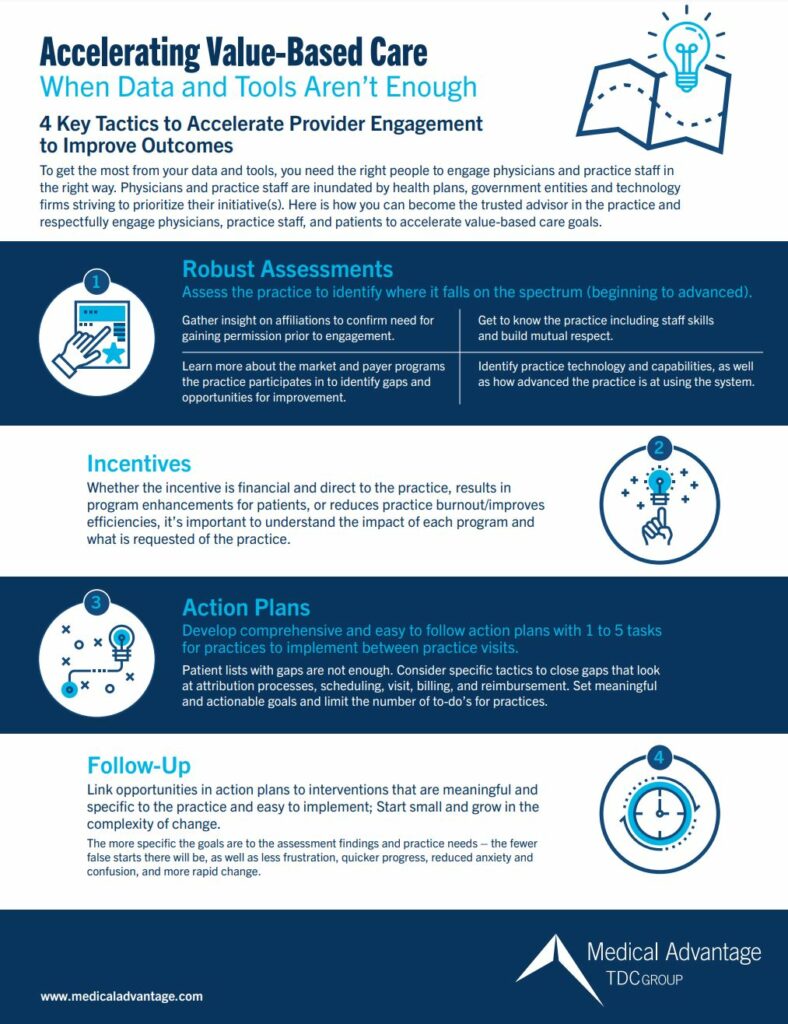For U.S. healthcare providers wondering how best to approach the industry-wide pivot to value-based care, there is no shortage of questions. These new reimbursement models— which reward quality of care, rather than volume of services— are full of potential financial promise for payers and providers alike. However, the transition from more traditional models is fraught with potential challenges.
Providers are increasingly making the switch from fee-for-service to value-based care (VBC) contracts. Meanwhile, the Centers for Medicare and Medicaid Services continue to implement policies pushing providers toward VBC, “ready or not.” That leaves many providers seeking solutions to help them adapt their business models to succeed in new payer contracts that focus on quality rather than quantity of care.
For many, healthcare quality dashboards are a welcome solution to this problem. These dashboards are a specific subset of healthcare dashboards that give clinicians and staff dynamic, real-time, and visual data oversight of trends in their patient care performance.
More specifically, “quality dashboards show performance at the ward or organizational level to inform operational decision making and quality improvement efforts,” according to the National Library of Medicine.
In short, quality dashboards give care providers a means of seeing, at a population-health level, how well patients are being cared for. This then allows care strategies to be recalibrated— resulting in improved patient outcomes and thus enhanced performance in value-based payer contracts.
Here are four specific ways healthcare quality dashboards are helping medical organizations succeed within new, value-based care models.
Quality dashboards inform and enhance business strategy
It’s no secret— healthcare hasn’t always had a reputation for being the most efficient sector. One recent study found that clinical waste accounted for between 5 and 15 percent of national health spending between 2011 and 2019, costing well into the hundreds of billions of dollars.
Healthcare quality dashboards help to eliminate this waste by ensuring that clinicians, staff, and practice managers reroute human and financial resources to where they make the greatest impact. For example, if a practice is falling behind on screening patients for a certain type of cancer, quality dashboards can reveal this fact—giving practice managers the chance to schedule those screenings promptly.
Not only does performing these services bring in immediate revenue, it also results in higher reimbursements for administering better preventative care. These kinds of services also result in fewer costs to the system by catching potentially costly health conditions before they become more serious.
Quality dashboards allow for benchmarking
For staff and clinic managers, assessing how well an organization is performing is one of their most important tasks. But without the necessary context, it can be difficult to do so.
Healthcare quality dashboards address this issue by displaying organizational data alongside national averages, allowing organizations to benchmark their performance. Once the differences have been established, executives can begin to understand why they may be over- or underperforming and then use those findings to address the problem.
For healthcare organizations, benchmarking is a powerful way to identify– and begin to correct– disparities in areas such as:
- Patient outcomes
- Contract performance
- Population health metrics
- Claim outcomes
- Revenue and reimbursements
Quality dashboards are real-time and dynamic
Healthcare reporting, or the compiling of raw data into usable reports, has long been synonymous with frustrating and redundant manual workflows. Before the onset of digital systems, healthcare organizations were often forced to compile paper-based reports manually, resulting in data printouts that were quickly obsolete. Even today, some organizations still use manual reporting methods.
Healthcare quality dashboards significantly reduce or even eliminate frustrating workflows and tedious manual reporting. Quality dashboards automatically and continually source your practice’s data (from what is known as a data lake, or data warehouse) and “pipe” that data right into the dashboard view.
The result is a system that displays real-time, up-to-date information about practice performance— without requiring staff to assemble manual reports. This not only frees up labor and reduces costs, but it also provides easily accessible and actionable performance insights as to performance.

Quality dashboards improve care quality
The goal of improving the quality of care delivered is at the heart of all new initiatives and innovations in healthcare. As the industry continues evolving toward VBC models, and providers increasingly enter quality-based contract arrangements, quality dashboards have emerged as a method to do just that— deliver a continually-increasing standard of care.
By giving care providers a clearer “window” into certain care metrics of their patient population, healthcare quality dashboards reveal, at a population-health level, which patients:
- Have underlying conditions that may impact their care
- Are due for certain procedures
- May be at risk for specific ailments certain ailments
Once this data is aggregated in one centralized, interactive interface, stakeholders can quickly ascertain which patients need what care, and when. Some of the most common quality dashboard Key Performance Indicators, or KPIs, include:
- Controlling High Blood Pressure
- HbA1c Control
- Diabetes Eye Exam
- Breast Cancer Screening
- Colorectal Cancer Screening
The result of this improved oversight is the opportunity to address gaps-in-care, deliver better outcomes, and increase performance in quality-based contracts all in one fell swoop.
In sum, a healthcare quality dashboard can provide insights that will help you monitor performance, benchmark populations, and improve performance in payer contracts.
CHAD ANGUILM is Vice President of Growth at Medical Advantage, which is a national healthcare consulting firm serving independent practices, practice groups, Managed Services Organizations (MSOs), and health plans and is a subsidiary of the TDC Group, the nation’s largest physician-owned malpractice insurer. For more information on healthcare dashboards, visit the company’s website at www.medicaladvantage.com/solutions/healthcare-dashboards/e-book/, or contact Chad Anguilm directly at canguilm@medicaladvantage.com.





